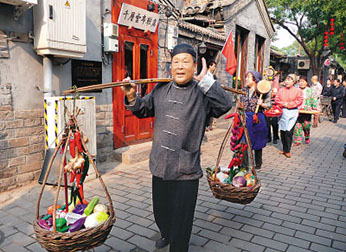HUTONGS IN OLD CHINA
Hutong in contrast to the court life and elite culture represented Iby the Forbidden City, Summer Palace and the Temple of Heaven, the hutongs capture the culture of the everyday folk who make Beijing what it is. These residential neighborhoods still form the heart of Old Beijing and are not to be missed.
Hutong is a type of narrow street or alley, most commonly associated with Beijing, that are in the past formed by lines of Silheyuan - traditional residences of four sided houses built around a courtyard. Many neighborhoods came about when several Siheyuan were built in an area, together with a series of alleys.
During China’s dynastic period, emperors planned the city of Beijing and arranged the residential areas according to the social classes of the Zhou Dynasty (1027 - 256 BCE). This system was still in use, until the term “Hutong” (a word which is actually Mongolian in origin and means “town”)first appeared during the Yuan Dynasty (1271 - 1368).
During the Ming Dynasty (1368 - 1644), the center of Beijing was the Forbidden City, which was surrounded by the concentric circles of the Inner City and Outer City. The Inner Citywas guarded by old city walls. Citizens of higher social status were permitted to live closer to the center of the circles (i.e. aristocrats lived just around the east and west of the imperial palace). The large Siheyuan of these high-ranking officials and wealthy merchants often were often carved and painted on the roof beams beautifully and elegantly, and the Hutongs were formed orderly and lined by spacious homes. Further from the palace, from north to south, were the commoners, merchants, artisans, and laborers. Their Siheyuan were far smaller in scale and simpler in design and decoration, and the Hutongs were narrower.
Following traditional Chinese Fengshui design, nearly all Siheyuan had their main buildings and gates facing south to accept vitalizing yYang- energy, and for this reason a majority of Hutongs face from theeast to the west. Between the main Hutongs, many tiny lanes get along from the north to the south for the convenience of an inter- Hutong travel.
Historically, a Hutong was also used as the lowest level of administrative division in a city in ancient China. One example of this was the Paifang (牌坊)system, where the largest division within was a fang (坊), equivalent to a current precinct. Each fang was enclosed by walls or fences, and the gates were shut and guarded every night, just like a modern gated community. Each Fang was further divided into several Pái(牌),which is equivalent to a current community or neighborhood. Each Pái contains an area that included several Hutongs.
Nowadays, the Hutongs are no longer used as the lowest level of administrative geographical division, but famousplaces ofhistoricinterest in Beijing.

HUTONGS IN OLD CHINA(10张)




